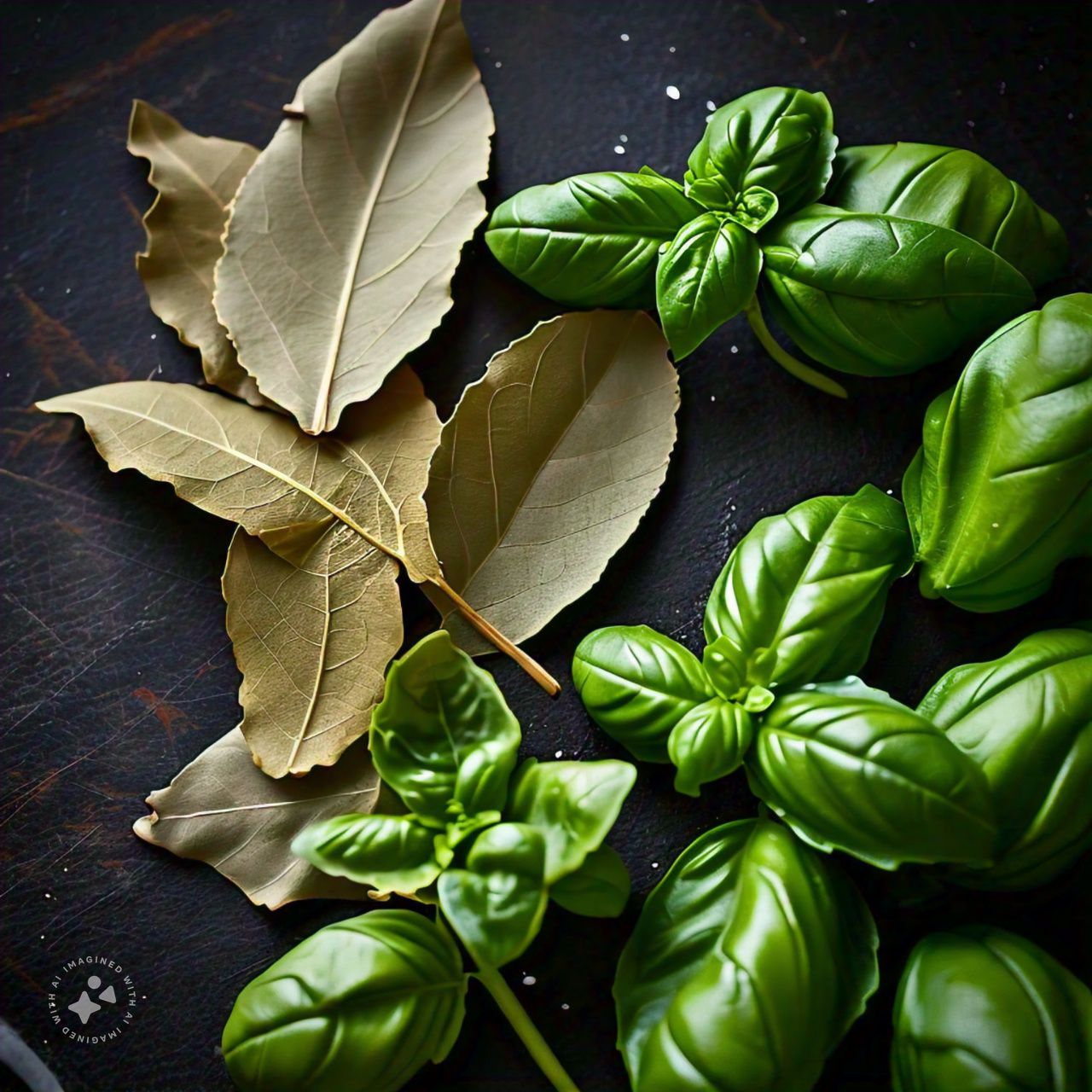No, basil leaves and bay leaves are not the same. They come from different plants and have distinct flavors.
Basil leaves come from the basil plant (Ocimum basilicum) and are commonly used in Mediterranean and Southeast Asian cuisines. Basil has a sweet and slightly peppery flavor and is often used in dishes like pasta, salads, and pesto.
Bay leaves, on the other hand, come from the bay laurel tree (Laurus nobilis). They have a more herbal and savory flavor, and they are often used in soups, stews, and sauces. Bay leaves are usually added to dishes during cooking but are removed before serving because they can be tough and indigestible.

Basil VS Bay Leaves
In summary, while either basil or bay leaves are used in cooking, they come from different plants and contribute distinct flavors to dishes.
What is the difference between Basil and Bay leaves?
People often confuse between basil and bay leaves and ask are Basil and bay leaves the same? Basil and Bay leaves are different in terms of their botanical origins, flavors, and culinary uses. Let discuss in detail regarding basil vs bay leaves.
1. Botanical Origins:
Basil comes from the basil plant (Ocimum basilicum), which is a member of the mint family. There are several varieties of basil, and they are often used in a variety of cuisines, including Italian, Thai, and Mediterranean.
Bay leaves come from the bay laurel tree (Laurus nobilis), which is an aromatic evergreen tree. Bay leaves are usually dried before use.
2. Flavor Profile:
Basil has a sweet and slightly peppery flavor with hints of clove and anise. It is commonly used in fresh form in salads, pasta, and pesto.
Bay leaves have a more herbal, savory, and slightly bitter flavor. They are often used to add depth to soups, stews, sauces, and braises. It’s important to note that bay leaves are not typically consumed; they are added during cooking and removed before serving.
3. Culinary Uses:
Basil is often used fresh in salads, sandwiches, and as a key ingredient in pesto. It can also be added to cooked dishes at the end of the cooking process to preserve its fresh flavor.
Bay leaves are usually added to dishes during the cooking process to infuse their flavor into the liquid. They are commonly used in soups, stews, sauces, and marinades. It’s essential to remove bay leaves before serving as they can be tough and have a sharp edge.
In brief, both basil and bay leaves are used in cooking; they come from different plants, have distinct flavors, and are utilized in different culinary applications. Basil is often used fresh, while bay leaves are used for their aromatic qualities in cooking.
What are the health benefits of Basil and Bay leaves?
Both basil and bay leaves offer certain health benefits, in addition to their culinary uses. Here are some potential benefits associated with each:
Basil:
1. Rich in Antioxidants:
Basil contains compounds such as flavonoids and polyphenols that act as antioxidants, helping to protect the body’s cells from damage caused by free radicals.
2. Anti-Inflammatory Properties:
Basil has anti-inflammatory properties that may help reduce inflammation in the body.
3. Potential Antibacterial and Antimicrobial Properties:
Some studies suggest that basil may have antibacterial and antimicrobial properties, which could contribute to its use in traditional medicine.
4. Rich in Nutrients:
Basil is a good source of vitamins A, K, and C, as well as minerals like calcium, manganese, and iron.
Bay Leaves:
1. Digestive Health:
Bay leaves are believed to have digestive benefits and can help alleviate digestive issues such as bloating and indigestion.
2. Anti-Inflammatory and Antioxidant Properties:
Bay leaves contain compounds with anti-inflammatory and antioxidant properties, which may contribute to overall health.
3. Blood Sugar Regulation:
Some research suggests that bay leaves may help regulate blood sugar levels, making them potentially beneficial for individuals with diabetes.
4. Respiratory Health:
In traditional medicine, bay leaves have been used to address respiratory issues such as congestion and coughs.
It’s important to note that while these herbs may offer health benefits, they are typically consumed in small quantities as part of a varied diet. As with any herbs or supplements, it’s advisable to consult with a healthcare professional, especially if you have specific health concerns or conditions.
What are the benefits of eating basil leaves daily?
Eating basil leaves daily can offer various health benefits due to the presence of essential nutrients and bioactive compounds. Basil is a good source of antioxidants, including flavonoids and polyphenols. Regular consumption may contribute to managing inflammation in the body. The antioxidants and other compounds in basil may contribute to heart health by helping to lower blood pressure, reduce cholesterol levels, and improve overall cardiovascular function.
The essential nutrients including vitamin K, vitamin A, vitamin C, manganese, and calcium play crucial roles in bone health, immune function, and overall well-being. Consuming basil leaves everyday aids digestion and relieves digestive discomfort.
Does basil and bay leaves tastes the same?
No, basil and bay leaves have distinct flavors, and they are not the same.
Basil has a sweet, slightly peppery taste with hints of clove and anise. It’s commonly used in Mediterranean and Italian cuisine and is a key ingredient in dishes like pesto, pasta sauces, and salads.
Bay leaves, on the other hand, have a more subtle and earthy flavor. They add a woodsy, herbal note to dishes and are often used in soups, stews, sauces, and braises. Bay leaves should be used sparingly because their flavor can be quite strong, and the leaves themselves are usually removed before serving.
While both basil and bay leaves are used to enhance the flavor of various dishes. They have different taste profiles and serve different culinary purposes.
What can I substitute for bay leaves?
If you don’t have bay leaves on hand or if you’re looking for a substitute due to personal preference or allergies, there are a few alternatives you can consider. Keep in mind that bay leaves have a distinctive flavor, so the substitutes won’t perfectly replicate it, but they can still add depth to your dish. Here are some common substitutes for bay leaves:
1. Dried Thyme:
Thyme has a similar earthy and slightly sweet flavor. Use dried thyme sparingly, as it can be potent.
2. Dried Oregano:
Oregano has a robust flavor that can work well in many savory dishes. Use a smaller amount than you would for bay leaves.
3. Dried Basil:
While basil has a different flavor profile, it can add a pleasant herbal note to your dish. Adjust the quantity based on your taste preferences.
4. Savory:
Savory is an herb with a peppery and slightly bitter taste. It can be a good substitute, especially in bean dishes, stews, and soups.
5. Herbes de Provence:
This is a blend of dried herbs, including thyme, oregano, rosemary, and sometimes savory. It can be a convenient substitute for bay leaves in many recipes.
6. Rosemary:
Rosemary has a distinctive pine-like flavor. Use it sparingly, as it can be quite potent.
Remember to adjust the quantities based on your taste preferences, as the intensity of flavors can vary among herbs. Additionally, if you are substituting with dried herbs, use smaller amounts compared to fresh bay leaves, as dried herbs tend to have more concentrated flavors.




